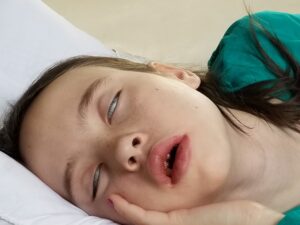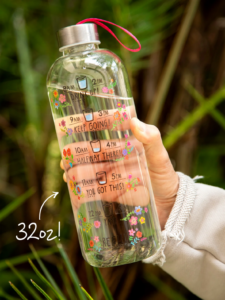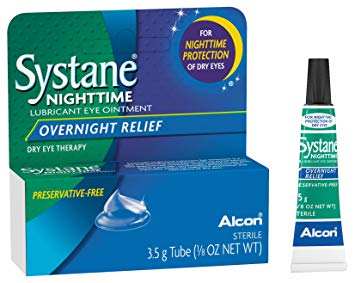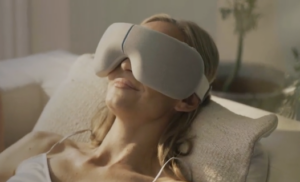by Helen Cave and the Women on Wellness group
Dry eyes, also known as Ocular Surface Disease (OSD), is a common issue with many in the FSHD community. Symptoms are often described as grittiness, itchiness, or burning especially upon waking up in the morning and/or later in the day. Some people say it feels as if something has got into the eye such as a tiny bug, piece of dust or sand, or an eyelash. Visually, one or both eyes may, on occasion, appear to be bloodshot. There can be light sensitivity. Vision sometimes is blurry. Curiously, an eye that suddenly becomes very watery or teary can also be a symptom of dry eyes. (Teary is when an eye drips or runs affecting the adjacent nostril and the flow won’t stop for a while. It usually affects only one eye/nostril at a time).

OSD results from the “facio” aspect of FSHD –weak facial muscles specifically of the small muscles adjacent to the eyes. This causes one or both eyes to be unable to shut completely when sleeping. This in turn dries out the natural lubrication present in the eyes. (Absent another person who observes you sleeping, it is hard to note whether one’s own eyes are partly open when sleeping!)
Taking a selfie photo of one’s eyes when open (and when shut) will usually display tell-tale signs that there is eye muscle involvement. There may be eyelid droopiness (ptosis) and often it is noticeable that each eye presents differently (related to the asymmetrical nature of FSHD).
What else can cause dry eyes?
Not every health issue in a person with FSHD is the fault of FSHD. It’s important to rule out other factors, especially if they can be remedied. Other medical conditions can cause dry eyes, including:
- diabetes
- rheumatoid arthritis
- scleroderma
- lupus
- Sjorgens syndrome
- shingles (if occurring in eye area)
- Graves disease
- thyroid conditions
- hormonal changes of pregnancy or menopause or aging
- scar tissue related to healing of injuries to an eye or eyelid
- some medications for other health conditions can cause dry eye
- allergies may be a factor in addition to having OSD related to FSHD.
Even weather conditions can contribute to, or worsen, the symptoms of dry eyes. Low humidity, wind and/or strong sunlight (think higher levels of UV readings) are other factors that may contribute to the development of dry eyes. Dry indoor air may be a factor in developing OSD.
About Coats disease
Most people who receive a FSHD diagnosis are told about their risk of Coats disease. It is an eye condition seen in some young children with early onset FSHD. Small blood vessels develop abnormally in the retina, the light-sensitive cells in the back of the eyeball. They can leak blood and cause damage, leading to vision loss. It is a relatively rare complication of FSHD and is not common in people with a later-onset diagnosis.
How can I be pro-active about treating my dry eyes?
It’s a good idea to get a medical confirmation of dry eyes. Book an appointment with an ophthalmologist/optometrist to share one’s symptoms and concerns. Explain the connection between FSHD and dry eyes. If possible, take along a photo (taken by someone else) of yourself while napping— especially if it shows incomplete closure of the eyes.
An ophthalmologist/optometrist is well acquainted with other medical conditions that can cause (or contribute to) dry eyes. As a precaution, they may suggest seeing your family doctor to rule out an additional health condition that may also be present in addition to FSHD.
If you see an optometrist first, they may choose to refer you to an ophthalmologist for further consultation. Symptoms of dry eyes may have caused damage which requires treatments and/or surgical procedures beyond what an optometrist can provide.
Note: Knowing which eye practitioner to initially see varies depending on where someone is located. Some countries require a referral from a GP or optometrist to see an ophthalmologist. Someone living in another country may be able to book directly with an ophthalmologist. Hence the use of ophthalmologist/optometrist in this post.
Are there self-help things I can do?

Yes, yes, yes!!!
To treat eye discomfort:
- Use eye drops during the day and lubricant gel at bed time;
- Tape your eyes shut (with medical-grade paper tape), seal them with plastic wrap, and/or use an eye mask at night;
- Clean eyes in the morning and before going to bed.
- Use a moist and/or heated mask on eyes for ten minutes once or twice a day.
It’s also important to take preventive steps:
- Be sure to keep hydrated throughout the day.
- Reduce caffeine consumption, as caffeine is dehydrating.
- Wear sunglasses (preferably the wrap around style) especially when it is sunny and/or windy outside.
- Most types of contact lenses are not very compatible with dry eyes.
- Avoid smoking, and stay away from smoky conditions
- Take regular breaks when using electronic devices.
- Blink regularly.
- Incorporate eye exercises into your daily routine.
- Have an annual eye check with an ophthalmologist/optometrist.
- Book an appointment with an appropriate medical professional if an eye problem occurs between annual check-ups.
- Ask that reports from all eye-related problems are copied to family doctor, optometrist, and ophthalmologist).
Suggestions shared by FSHD’s Wellness Group members
As packaging for the following products is small, you may need a magnifying glass to read the information on the boxes of various eye products!
Eye Drops
 As OSD tends to be an ongoing concern for people with FSHD, an important consideration is to choose drops that are preservative free. Your ophthalmologist/optometrist or pharmacist will know some brand names and specific types to recommend.
As OSD tends to be an ongoing concern for people with FSHD, an important consideration is to choose drops that are preservative free. Your ophthalmologist/optometrist or pharmacist will know some brand names and specific types to recommend.- Some group member suggestions included Systane, Refresh, Thera Tears, MGD Drops, Alcon GenTeal Drops, HyLo Forte eye drops, and Similasan Dry Eye Relief. There are more brands available than what is listed here.
- Check online or at a local pharmacy for specific products of these brands that are geared to treat dry eye symptoms long term and are preferably preservative free. Preservatives can be irritating to dry eyes.
- Sometimes, depending on eye health, an ophthalmologist will prescribe eye drops if there is damage to the eye surface or an infection. These drops may be contained in a small plastic bottle or in vials. Ask the prescribing doctor or pharmacist for hints and specific directions on when and how to use these drops (and for how long).
- Wash or cleanse your hands prior to using eye drops.
- Initially, getting eyedrops into the eye may be a learning process, especially if your arm or hand dexterity is limited by FSHD.
- Some hints include tipping your head back or laying down or tipping/reclining back in a wheelchair or recliner chair. Rest one hand on the bridge of your nose, while using your other hand to hold onto the eye drop bottle. Using your hand (that is resting on your nose), pull down your lower lid, and, holding the bottle a bit above the eye, squeeze a drop into the lower pocket of the eye. Close your eyelid and slowly rotate your eyeball to spread the drop. Do this a couple of times to ensure that as much of the drop spreads throughout the eye area. Repeat with the other eye.
- Alternately it may be easier to do a search online for a small product called “AutoDrop” or “AutoSqueeze”. One reasonably priced AutoDrop can be found at this website: OwenMumford.com. The instruction page describes how to use the AutoDrop. Go to Medical Devices, then click on Eye Care. Similar products are also available online or in pharmacies.
- Some people with FSHD (whose hands or arms/shoulders are weak) may need another person to assist with using eye drops and gel.
- See the end of these notes for a helpful link to an article and video with helpful points for getting drops into eyes.
Eye gel or lubricating ointment
- This type of product is often recommended for overnight lubrication of dry eyes.
- Your ophthalmologist/optometrist are good sources for recommending specific brands.
- Follow above directions (see eye drops section) for inserting gel or ointment into your eyes at bedtime.
- If you are having difficulty getting gel into the eye, you can put the gel onto your baby finger (that is freshly washed and very clean) and place the ointment into the lower eyelid pocket.
- Note: eye gels and ointments may temporarily cause vision blurriness.
- Some suggested gels or ointments used by Wellness group members: Muro123, HyLo eye gel, Refresh PM, Lacrolube eye gel, and Systane Lubricating Gel (labelled for severe dry eye relief).
- Dry eye ointments are thicker and usually composed of a mixture of Vaseline and oil (formulated to be safe for using in eyes). Systane Eye Ointment, Condorvision Ocunox Eye Ointment or GenTeal ointment (for severe dry eyes).
Keeping eyes shut while sleeping: Masks and related products
-

SmartGoggles Some Wellness group members find it helpful to use Medical Grade Paper Tape to keep eyelids closed while napping or sleeping.
- Other group members wear masks to protect eyes. Some people use both.
- A couple of eye mask products recommended by Wellness members are: Alaska Bear Sleep Mask for Side Sleepers & MZOO sleep eye mask. Many pharmacies sell eye masks.
- This website compares several eye masks in detail and includes a good video too! Go to: nosleeplessnights.com. Under Sleep Products, go to Sleep Masks.
- Another option is to use a product like a night cap that is designed to cover the eye area as well. See: nitehood.com
- Alternately, search online for DIY directions to make sleep masks. Here’s one of our own.
- Also check out washing care of eye masks, special laundry directions to keep masks clean.
Note: Comparing prices (in stores or online) of eye drops, gel or ointment, and eye masks is often worthwhile!
Keeping eyes and eye area clean
- For long-term OSD ask your optometrist /ophthalmologist for the best way to keep your eyes and eye area clean. They may recommend using baby shampoo and/or special eye wipes once or twice a day depending on the severity of your dry eyes. Ask them for specific advice.
- Some eyelid wipes recommended by Wellness group members: Dr. Fisher’s Purified Eye Wipes, Acusoft Eye Wipes (available at Walmart), and Systane Lid Wipes.
- If you use cosmetics, ask your ophthalmologist/optometrist for recommendations about eye makeup products. Some types of eye makeup tend to dry and flake. Those flakes can fall into the eye causing irritation.
- Wearing wraparound sunglasses protects eyes from UV damage when outside. It also limits dust getting into eyes or on the surrounding eye area if it is windy.
Be sure hands are clean before applying drops, gel or ointment to eyes or cleaning the eye area.
Eye exercises and lid massage
- Moist heat is often recommended for dry eyes by ophthalmologists/optometrists.
- A freshly clean, wet washcloth placed on the eyes for a few minutes is one option.
- You can purchase eye masks that can be heated (in a microwave) and placed on closed eyes. Be careful not to overheat the mask.
- One example is Bausch & Lomb’s Thera Pearl. Another product is an OcuSci Dry Eye Compress promedeyehealth.com. This can be heated briefly in a microwave or oven. It has a removable hypoallergenic washable cover and is advertised to last for years. Search online (or at local pharmacy for other product choices).
- Check out therabody.com for Smart Goggles. This digitally controlled eye mask can provide eye massages and help relieve eye strain. It is not a cheap product but may be helpful if dry eye symptoms are more serious.
- Another practice that can be helpful is to do some gentle massage on and around your eyes. Search for some directions by typing in gentle eye massage on your device’s search box.
- Take a break when doing close-up tasks or watching TV. It’s recommended to stop activity every 20 minutes and look at an object 20 feet away for at least 20 seconds.
- Try to make it a habit to incorporate regular blinking (several times in a row) during the day. This helps lubricate dry eyes (compared to not blinking often).
Work those eyes!
- It’s easy to overlook the value of eye exercises. The following are easy to do & helpful to strengthen the fine eye muscles while countering some of the side effects of dry eyes. Do a few times daily if possible!
- Raise eyebrows up and down 10 times in a row. Shut eyes (also known as blinking) at least 10 times in a row. With eyes open, look up and then down 10 times in a row. Close eyes and then scrunch them tight. Repeat 10 times.
- With eyes open, move eyeball up / then down & from side to side. This exercise can also be done with eyes shut.
- Frown several times (suggested 10 times) focusing on scrunching up area just above bridge of your nose.
- Roll eyeballs in a complete circle clockwise and then counterclockwise.
What complications can occur if OSD is ignored and untreated?
- Increased risk of eye inflammation and/or infection.
- Scarring and abrasion of corneal surface, corneal ulcers.
- Blurred and/or decreased vision.
- Reduced ability to read or do closeup work / loss of driving license.
- Can also interfere with sleeping patterns impacting daytime energy and mood.
Surgery to help with dry eyes
- Tear Duct Plugs
- Lower Eyelid Blepharoplasty (a procedure to lift lower eyelid)
- Tissue Transplant (a small piece of donated tissue is inserted under the lower eyelid)
- Surgery to lift upper eyelid “droop” (droop is also known as Ptosis)
- There are other eye surgeries that sometimes are done to help with OSD complications.
- Be sure to inform the surgical ophthalmologist that your OSD is likely caused by FSHD due to some weak eye muscles.
How can I learn more about dry eyes and recommended treatments?
There are several reliable medical sites on the Internet that have up to date information about OSD (ie Mayo Clinic, Cleveland University, John Hopkins and others). In addition . . .
- Go to FSHD Society’s home page and do a search for “dry eyes”.
- A search for dry eyes can also be done on the Living With FSHD Facebook page.
- The American Academy of Ophthalmologists (AAO) website has several pertinent articles (some with videos) related to OSD. Go to: aao.org then click Public & Patients / then Eye Health A-Z. (Tips & Prevention is also a good section to explore at this site).
- Some topics to type into the AAO search box include: What is Dry Eye? Symptoms, Causes & Treatments (article & video); How to Put in Eye Drops ( a very good article with video) ; Lubricating Eye Drops; Additives Can Irritate Eye; & Dry Eye Tips.
- The following short articles are also found on the AAO website: Burning Eyes; Tearing; Grittiness; Irritation; Corneal Abrasion; Corneal Erosion along with other eye related topics.
- A very informative article on Hydration For Wheelchair Users at mdaquest.org.


Great tips! Taking care of our eyes is important for everyone, and these practical suggestions are easy to incorporate into our daily routines.
I have found a good working method that keeps my eyes closed while I sleep. I use a “Tranqileyes” eye cover available at The Dry Eye Shop or other online sites. I dot no use the central foam inserts. I use a 4″ x 4″ gauze pad between tranquaileyes foam rings and my eyes. I change out the gauze every 3-4 days. I have also cut out a hole in the opaque blue section of the cover to let in air and light. I need the light to wake up in the morning. Before using this I would have to put hot wet compresses on both eyes to get them open each morning. I was being considered for plastic surgery on my left eyelid which was was limiting my field of vision. Within 6 weeks the eye droop had completely resolved and all eye irritation went away. Gels and eye drops never provided any relief.